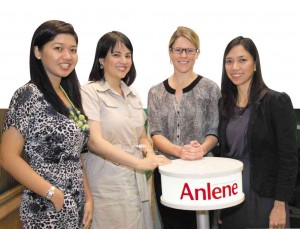Such is the finding of Fonterra, a multinational dairy company based in New Zealand and maker of Anlene milk, which has been campaigning for bone health since 1999, when it introduced the bone scan technology in the Philippines.
The International Osteoporosis Foundation defines osteoporosis as “a disease in which the density and quality of bone are reduced. As the bones become more porous and fragile, the risk of fracture is greatly increased.”
Sadly, osteoporosis is only diagnosed when a fracture occurs—usually in the hip, spine or wrist.
Annie Robinson, Fonterra senior nutritionist, said in a recent talk held at Makati Shangri-La that osteoporosis is a global health concern that isn’t getting as much attention as cancer or stroke. Fonterra is bent on making Filipinos more aware of the disease, and has recently released a P100 million fund for an osteoporosis-awareness campaign.
Free bone scans
This information-dissemination group is composed of 26 mobile teams of 150 people. They provide free bone-scan sessions, lectures and seminars done in accessible areas such as malls, schools, supermarkets, churches.
The Anlene Bone Health Check caravan has covered Metro Manila and most of Luzon, plus key cities in Visayas and Mindanao. It has pitstops lined up in Tuguegarao, Ilocos, Sorsogon, Zamboanga, Iligan and Butuan.
There are 36 bone-scan machines in the Philippines, each costing around P1 million. The machine is a small, easy-to-transport device that determines how healthy your bones are. It has a slot where you place your foot, then two small “balloons” inflate and squeeze both sides of your heels to get an impression. The non-invasive procedure takes a few minutes and you will be categorized as “low risk, moderate risk and high risk.” To make sure the results are accurate, the machines are checked every quarter.
‘At risk’
Bone breakdown starts as early as 25, and being “at risk” means one is likely to have osteoporosis by 50 years old, explained Anna Pablo, Fonterra senior nutritionist.
Out of 1,088,991 respondents who had bone scans from June 2005-February 2011, 509,258 or 47 percent are classified as moderate and high risk, and are “at risk.” The subjects are from four age groups (30 and under, 31-40, 41-50, 50 and up), and mostly female.
“This means 1 out of 5 men, and 1 out of 3 women may eventually have osteoporosis and fractures,” she said.
There are many reasons for Filipinos’ low bone health, among them genetic predisposition, a sedentary lifestyle, lack of exercise and a diet that doesn’t pack enough calcium, a mineral necessary for good bones (99 percent of calcium in the body are in the bones and teeth, 1 percent is in the blood).
“An average Filipino adult gets only 370 mg of calcium, instead of the recommended daily allowance of 750 mg,” she said. Most Filipinos don’t drink milk regularly, or consume calcium-rich food. Add to that the preference for junk and fast-food.
Caffeine also “eats” up the calcium in the body, added Robinson, so coffee drinkers are more prone to have osteoporosis later on in life. You can still have coffee daily, but limit it to one to two servings a day.
Also, watch out for the caffeine in creamy cold or blended coffee and chocolate drinks which are so easy to consume, reminded Louise Yu, Anlene senior brand manager.
What to do
The Fonterra nutritionists set guidelines on how to prevent osteoporosis at any age. It is best, though, to start early.
If you are lactose-intolerant (the inability of the body to process lactose found in milk, resulting in unpleasant abdominal activity; a common condition among Asians), you can try drinking milk until your body regulates it well.
Eat calcium-rich food like cheese, yoghurt, salmon, broccoli and okra.
Move it. Work out to increase bone density.
Have a bone scan yearly.